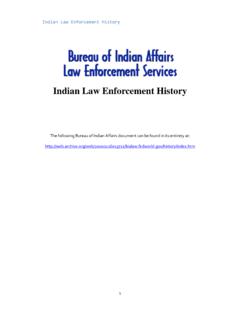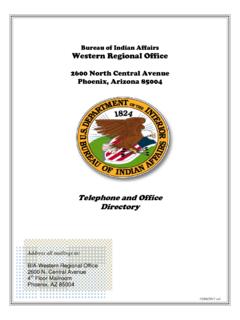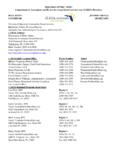Transcription of U.S. Department of Housing and Urban Development Office …
1 Department of Housing and Urban Development Office of Public and Indian Housing Special Attention of: Notice PIH-2014-22 All Section 184 Approved Mortgagees, Effective: September 16, 2014 Indian Housing Authorities, Expires: This Notice remains effective until Tribally Designated Housing Entities, until amended, superseded, or rescinded and Tribes SUBJECT: Section 184 Indian Loan Guarantee Program Processing Guidelines. PURPOSE: The purpose of this Notice is to provide information to lenders that make loans under the Section 184 Program to individual tribal members, about HUD s guidelines and procedures for issuing loan guarantees. HUD intends to issue a comprehensive guidebook on the guidelines and procedures that must be followed for the Section 184 program.
2 It will cover both the servicing requirements in PIH 2014-11, and the underwriting guidelines of this Notice. Until then, this Notice provides guidance on the guidelines and procedures that must be followed for HUD to guarantee a Section 184 loan. BACKGROUND: The Indian Housing Loan Guarantee program is authorized by Section 184 of the Housing and Community Development Act of 1992, 102-550, enacted October 28, 1992, as amended. Regulations are at 24 CFR part 1005. The Section 184 program addresses the special needs of American indians and Alaska Natives by making it possible to achieve homeownership with market-rate financing. Historically, American indians and Alaska Natives have had limited retail banking opportunities and limited access to private mortgage capital, primarily because much of the land in Indian Country is held in trust by the federal government.
3 Land held in trust for a tribe cannot be encumbered or alienated, and land held in trust for an individual Indian must receive federal approval through the Bureau of Indian Affairs before a lien is placed on the property. This loan guarantee program maximizes a relatively minimal federal investment by insuring approximately 4,000 loans each year, and by expanding markets for lenders. The program provides an incentive for private lenders to market loans to this traditionally underserved population by guaranteeing 100 percent repayment of the unpaid principal and interest due in the event of default. Lenders get the guarantee by making mortgage loans to American Indian and Alaska Native families, Indian tribes, and tribally designated Housing entities to purchase, construct, refinance, and/or rehabilitate single family homes on trust or restricted land, and in tribal areas of operation.
4 There is no income limit or minimum required to participate, but borrowers must qualify for the loans. This Notice explains how the Section 184 program advises lenders to underwrite purchase transactions. All lenders should ensure that all necessary information has been included in the loan file. The Office of Loan Guarantee, which operates the Section 184 program, reserves the right to return to lenders any incomplete packages. 2 GUIDELINES: 1. Overview and Qualification of Applicants Overall, underwriters should focus their review on two major factors: (1) prospect of loan repayment; (2) and the property value. Eligibility: For applicants to be eligible for a Section 184 loan, they first must meet the following two threshold qualifications: 1) Membership in Tribe- An applicant must be a member of a federally recognized tribe, a regional or village corporations as defined in the Alaska Native Claims Settlement Act, or one of the following five state tribes: Coharie Tribe (North Carolina); Haliwa-Saponi Tribe (North Carolina); Lumbee Tribe (North Carolina); Waccamaw Siouan Tribe (North Carolina); MOWA band of Choctaw (Alabama).
5 To determine if a tribe is federally recognized, the underwriter should consult the Bureau of Indian Affairs website for the most up-to-date tribal directory (found at ). Proof of membership or enrollment in a federally recognized tribe (or one of the five approved state tribes) will be determined through possession of a tribally issued enrollment card or through possession of a letter from the tribal enrollment Office stating that the applicant is a member of the tribe. Alaskan Corporation Membership- To determine if a regional or village corporation in Alaska is eligible for the Section 184 program under the Alaska Native Claims Settlement Act, the lender must consult the list of eligible corporations on the HUD website at: Membership in an eligible Alaskan corporation will be determined by whether the applicant can demonstrate possession of a common stock in one of the approved Alaskan corporations.
6 A copy of the common stock certificate must be included in the loan file. 2) Indian Operating Area- the property that will be the security for the mortgage that is guaranteed by the Section 184 program must be in an approved Indian operating area. As of 2014 there are Indian operating areas in 39 states. The map of approved Indian operating areas can be found on the HUD website at: Note: Eligible tribal members are not limited to purchasing a home in a place where their tribe is authorized to provide Housing . For example, if an Oklahoma tribal member wants to purchase a home in Alaska that is allowed. Applicant Prequalification- HUD does not prequalify applicants. Lenders are responsible for ensuring applicants meet the program requirements prior to requesting the assignment of a case number.
7 Once the eligibility thresholds have been satisfactorily determined, an eligible lender should request a case number from the Office of Loan Guarantee. The case number request should be submitted on HUD Form 50131. A case number is valid for up to 180 days from issuance. Unless an extension is requested from the Office of Loan Guarantee, after 180 days case numbers will be cancelled by HUD without further notice and a lender must send a new request for a case number. 3 At the time that a case number is requested, the lender will need to determine whether the property is located on land held in trust by the federal government and if so, whether they want to underwrite the loan themselves, through the Direct Guarantee process, or whether they want to send it to HUD for underwriting.
8 However, before HUD can underwrite any loan, the lender will need to secure documentation from the tribe s Environmental Review Record (ERR) verifying that an environmental review was performed in accordance with 24 CFR Part 58 by the tribe whose land is impacted by the proposed mortgage. Also, except where the ERR documents that the proposed action is exempt under 24 CFR 58, the tribe whose land is impacted will need to send HUD a Request for Release of Funds, which will have to be approved by HUD as part of the underwriting process. Please note that lenders must utilize the direct guarantee process for underwriting all loans occurring on lands that are not held in trust by the federal government and that there is no environmental review required for these loans (except in the case of a waiver involving collateral under Section of this Notice).
9 For questions on how to become approved to be Direct Guarantee lender, please see the Section 184 website at: If a loan file is to be underwritten by HUD staff, all documentation should be two-hole punched, bound in a legal-sized folder, and organized in accordance with the applicable checklist HUD form 50127. This folder should have a label with the applicant s name and case number. The file should be shipped, to the loan guarantee specialist designated on the case number request form. 2. General Operating Information Application Format- Lenders must submit a Uniform Residential Loan Application (URLA) for all applicants. The application must be signed by both the applicant(s) and the loan officer, or other appropriate person from the lender. Criteria for Review of Application- The underwriting review assesses the applicant s ability and willingness to repay the mortgage debt.
10 1) The applicant s ability to repay the debt is assessed by considering income history and stability; employment history and stability; and debts. 2) The applicant s willingness to repay the mortgage debt is assessed by considering both credit and pay history. Age of Documentation- Credit, income, and valuation verification may not be older than 60 days at underwriting and may not be older than 120 days when the loan closes. Since some loans will take longer than this to close, lenders may have to update credit and income information periodically during loan processing. An underwriter must use the most recent information available in making an approval decision. General Authorization- Rather than requiring applicants to sign multiple verification forms, the lender may have the applicant sign a general authorization form that gives the lender blanket 4 authority to verify the information needed to process the mortgage loan application.














